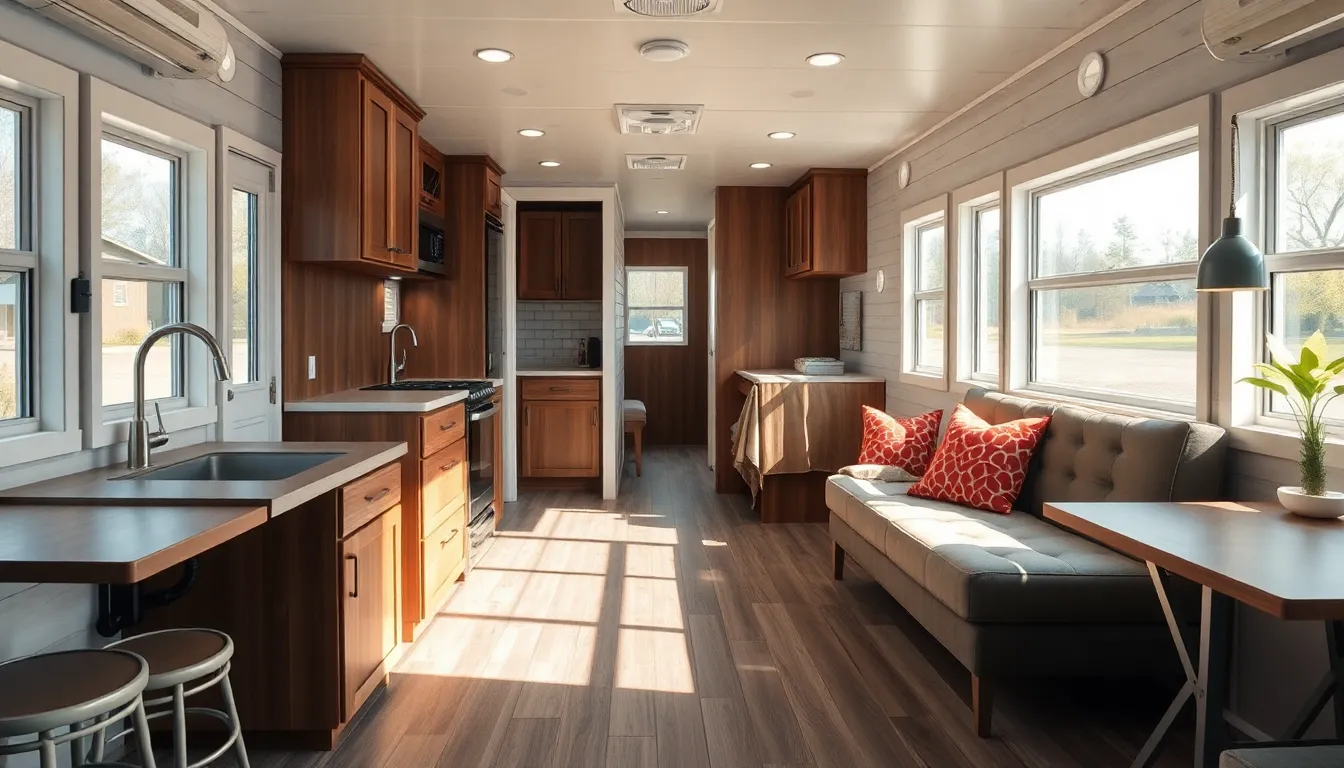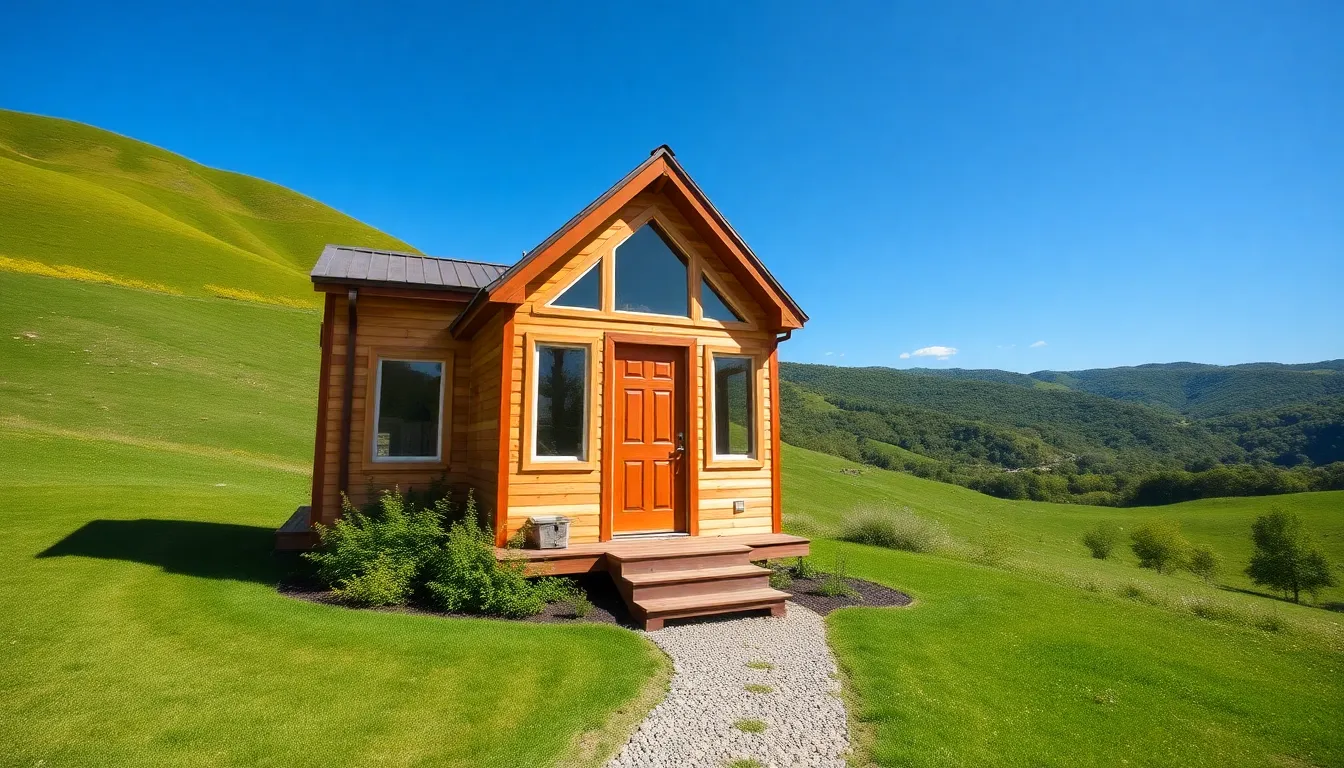In a world where bigger often seems better, tiny homes are making a bold statement—less really can be more. These pint-sized powerhouses offer cozy living with a dash of charm, but what happens when accessibility takes a backseat? Navigating life in a tiny home shouldn’t feel like an Olympic sport. With thoughtful design and a sprinkle of creativity, tiny homes can be just as accessible as their larger counterparts.
Imagine a space where everyone can enjoy the comforts of home without the hassle of navigating tight corners or climbing Everest-like stairs. Tiny home accessibility isn’t just a trend; it’s a necessity for many. As more people embrace this minimalist lifestyle, it’s crucial to ensure that these compact dwellings are welcoming for everyone. Let’s explore how to turn those charming little spaces into accessible havens without sacrificing style or comfort.
Table of Contents
ToggleUnderstanding Tiny Home Accessibility
Tiny home accessibility emphasizes the significance of creating adaptable spaces for all individuals. Designing with accessibility in mind opens tiny homes to a wider audience.
Definition of Tiny Homes
Tiny homes refer to compact living spaces typically ranging from 100 to 400 square feet. Various designs, including mobile and stationary options, fall under this category. Many feature innovative layouts that maximize utility, often incorporating multifunctional furniture. Building materials vary but often include environmentally friendly options, appealing to those who prioritize sustainability.
Importance of Accessibility in Tiny Homes
Accessibility in tiny homes promotes inclusivity and comfort for diverse occupants. Thoughtful design contributes to seamless navigation for individuals with disabilities. The U.S. Census Bureau reports that about 19% of Americans live with a disability, highlighting the necessity of accessible living environments. Features like wider doorways and lower countertops ensure usability for all. Incorporating ramps and accessible bathrooms can enhance safety and independence, addressing potential barriers within these compact spaces.
Key Accessibility Features
Accessibility features in tiny homes enhance their usability for individuals with varying mobility needs. Thoughtful design ensures comfortable living while maintaining functionality.
Design Considerations
Wider doorways facilitate easier navigation for people using wheelchairs or walkers. Lower countertops cater to individuals who may struggle with reaching higher surfaces. Adequate turning radii in kitchens and bathrooms allow for better movement. Non-slip flooring improves safety, significantly reducing the risk of falls. Lever-style hardware on doors and faucets simplifies operation for those with limited hand strength. These design features make tiny homes welcoming and practical for all residents.
Space Utilization Techniques
Smart storage solutions maximize limited space in tiny homes. Multi-functional furniture like fold-out tables and expandable seating offers flexibility. Wall-mounted shelves utilize vertical space efficiently, keeping floor areas clear. Incorporating hidden compartments in stairs or benches creates additional storage without sacrificing style. Modular layouts allow for easy reconfiguration as accessibility needs change. These techniques maintain an open, accessible environment while ensuring comfort and safety.
Benefits of Accessible Tiny Homes
Accessible tiny homes provide numerous advantages that enhance the living experience for all residents. These benefits include enhanced mobility and improved affordability and sustainability.
Enhanced Mobility
Enhanced mobility is a significant benefit of accessible tiny homes. Wider doorways, lower countertops, and open floor plans create seamless navigation for individuals with varying mobility needs. Increased turning radii in kitchens and bathrooms facilitate movement, ensuring safety during daily activities. Non-slip flooring reduces fall risks, supporting confidence in movement. Accessible features like grab bars and lever-style handles promote independence. Thoughtful designs allow residents to move freely while accommodating their lifestyles. These enhancements cultivate a more inclusive environment, inviting everyone to enjoy the benefits of tiny home living.
Affordability and Sustainability
Affordability and sustainability are notable advantages of accessible tiny homes. Designing for accessibility often aligns with cost-effective construction methods. These homes typically feature energy-efficient appliances and materials that reduce utility expenses. Smaller living spaces demand less energy for heating and cooling, promoting an eco-friendly lifestyle. Accessibility-focused designs often incorporate repurposed materials, minimizing waste during construction. Additionally, maintaining a tiny home requires less time and resources, decreasing overall financial burden. By combining affordable design with sustainable practices, accessible tiny homes present a practical solution for many individuals and families seeking a simplified living arrangement.
Challenges to Implementing Accessibility
Accessibility in tiny homes encounters specific challenges that need addressing for optimal integration. These obstacles can arise from regulations and financial constraints.
Zoning and Legal Barriers
Zoning laws and building codes present significant barriers to accessible tiny home design. Many areas enforce strict regulations that dictate property dimensions, structure placement, and design features. These laws may restrict necessary accessibility modifications or limit the types of materials that can be used. Furthermore, obtaining permits often involves a lengthy process, which can discourage potential builders. Adhering to these zoning restrictions takes time and expertise, complicating the implementation of efficient accessibility solutions.
Cost Implications
Cost considerations play a crucial role in the feasibility of accessibility features in tiny homes. Incorporating elements like wider doorways or accessible bathrooms typically increases initial construction expenses. Finding affordable options for high-quality materials becomes imperative. While these investments provide long-term benefits and enhance living comfort, many builders face budget constraints. Additionally, customizing designs to meet accessibility needs often requires skilled labor, which can further elevate costs. Striking a balance between affordability and accessibility can prove challenging for both builders and prospective homeowners.
Future of Tiny Home Accessibility
Emerging trends indicate an increasing focus on tiny home accessibility. As the demand for tiny homes rises, designers and builders prioritize inclusive features. Incorporating smart technology is becoming common, allowing for greater control over accessibility adaptations.
Market research shows that about 19% of Americans live with disabilities. This statistic underscores the necessity for thoughtful design that accommodates diverse needs. Wider doorways remain essential for navigation, while adjustable features help personalize the living experience for all occupants.
Developers are exploring modular designs that offer flexibility. These structures can transform based on individual requirements, enhancing usability over time. Safety remains a priority, prompting innovations in flooring materials and hardware options.
Builders face the challenge of compliance with zoning laws and regulations. Adapting spaces to fit legal requirements can present obstacles. However, crafting affordable solutions doesn’t have to compromise accessibility or quality. Many builders are finding ways to source high-quality, cost-effective materials that support adaptive design without inflating budgets.
Sustainability is also gaining traction in tiny home designs. Eco-friendly materials align with accessible features, creating a dual benefit for residents. Enhanced energy efficiency often appeals to a broader market, making these homes more attractive to a wider audience.
Investment in education and training for builders will further pave the path toward inclusive tiny homes. Awareness of accessibility issues can lead to more skilled labor capable of implementing innovative solutions. Future trends suggest a vibrant marketplace focused on comfortable, accessible, and sustainable living spaces for everyone.
Conclusion
Tiny home accessibility is more than a trend; it’s a necessity for fostering inclusivity and comfort. As the movement continues to grow, the focus on thoughtful design will pave the way for more adaptable living spaces that cater to diverse needs.
Innovative features and smart space utilization not only enhance usability but also align with sustainable practices. While challenges like zoning laws and initial costs persist, the commitment to creating accessible tiny homes is gaining momentum.
With increasing awareness and investment in education, the future looks promising for those seeking a simplified yet functional lifestyle. Ultimately, accessible tiny homes can offer a welcoming environment for everyone, ensuring that cozy living is attainable for all.







